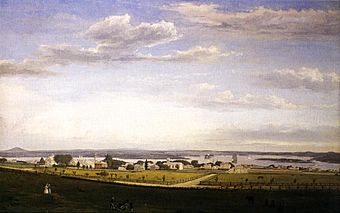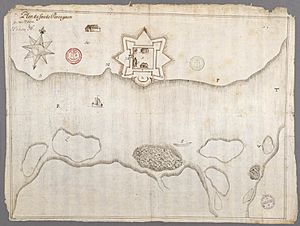Pentagoet Archeological District facts for kids
|
Pentagoet Archeological District
|
|
 |
|
| Location | Castine, Maine |
|---|---|
| Built | 1629 |
| NRHP reference No. | 93000603 |
Quick facts for kids Significant dates |
|
| Added to NRHP | April 12, 1993 |
| Designated NHLD | April 12, 1993 |
The Pentagoet Archeological District is a very important historical place. It is located in Castine, Maine, on the southern edge of the Bagaduce Peninsula. This area is known as a National Historic Landmark District.
It is the site of Fort Pentagouet, a strong trading post from the 1600s. French fur traders from Acadia built this fort. From 1635 to 1654, it was a busy place for trade. French traders met with the local Abenaki people here. The fort also marked the western edge of Acadia, next to New England.
From 1654 to 1670, the English controlled the site. Then, the Treaty of Breda gave it back to France. In 1674, Dutch raiders destroyed the fort. Today, the site is a public park. It became a National Historic Landmark in 1993.
Exploring the History of Fort Pentagoet
This area was once the home of the Abenaki people. Specifically, the Penobscot tribe lived here. The location was perfect for trade. It sits at the tip of the Bagaduce Peninsula. Here, the Bagaduce River flows into Penobscot Bay.
Around 1629, a man named Claude de Saint-Etienne de la Tour set up a small trading post. He traded with the Tarrantine Indians, who are now called the Penobscots. Later, Englishmen from the Plymouth Colony took over the site. They ran the trading post from 1629 to 1635.
The land was returned to France in 1632. This happened because of the Treaty of Saint-Germain-en-Laye. In 1635, Charles de Menou d'Aulnay built a stronger, fortified trading post. The Abenaki people often visited this post. They traded moosehides, sealskins, beaver pelts, and other furs. In return, they received goods from Europe.
d'Aulnay had disagreements over the fur trade. He argued with Charles de la Tour, Claude de la Tour's son. This conflict is sometimes called the Acadian Civil War. La Tour eventually won this struggle. He even married d'Aulnay's widow after d'Aulnay died.
La Tour and other French governors managed the trading post. This continued until 1654. At that time, English forces took control of Acadia. The site stayed in English hands until 1670. However, French traders likely kept managing the post.
The Treaty of Breda returned the post to France in 1667. But in 1674, Dutch raiders completely destroyed it. It took a long time for people to settle in the area again. This was partly due to King Philip's War. This was a big Native American uprising in New England from 1675 to 1678.
Uncovering the Past: Archaeology at the Site
In the early 1980s, a big dig happened at the fort's location. Archaeologists carefully uncovered about half of the fort's inner area. They found many important parts of the fort.
These included barracks (where soldiers lived) and a church. They also found a military magazine (for supplies) and a workshop. Researchers believe they even found d'Aulnay's home. They used direct digging and ground-penetrating radar to find these features.
The district was named a National Historic Landmark District in 1993. It was also added to the National Register of Historic Places that same year. This means it is a very important place for understanding history.




